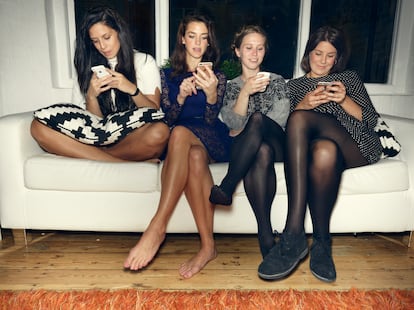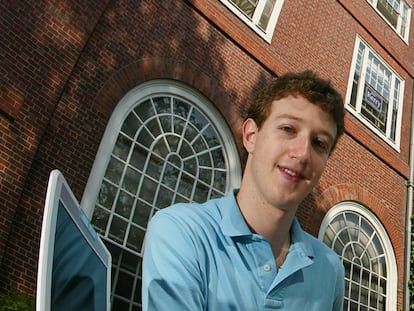Digital body language: How non-verbal communication works on social media
In the past, we examined people’s looks or subtle movements. But now, on Instagram or WhatsApp, we place value on the frequency of interactions, the use of emojis, or the speed of a response

Pedro and María went on their first date in the late 1990s. They sat in a cafe, chatting and having something to drink. Between phrases, their bodies leaned forward: there was a slippery look accompanied by a knowing smile, a hand that lightly touched a leg at a certain moment… all these non-verbal communication signals added a lot of information to the conversation they were having.
Fast-forward to the present day. Clara and Laura are in their twenties. They’re currently getting to know each other, intensely communicating through instant messaging applications and social media. All those important gestures and looks that Pedro and María engaged in before have now been transferred — with their own twist — to the digital world. They’re visible in the form of signals, or what is now known as digital body language (DBL).
With conversations taking place through digital media, the need arose to add intonation to written phrases. Emoticons subsequently appeared, followed by emojis. In the study Deciphering Digital Body Language and the Gen-Z in New Normal, published in January in the journal Creative Saplings, the researchers concluded that “non-verbal graphics (emojis) change the context of written communication. The receiver and sender understand the words and sentences behind non-verbal cues.” Now, with DBL, this goes one step further, by adding more digital, non-verbal signals to the use of emojis, such as frequency, response time, or message length, among others.
The online dating application Hinge has studied the use of this type of digital language among its users. The company has found that the majority (77%) feel that the digital language employed by a match reveals a lot about their intentions: 69% of users take it into account to decide if they want to continue with the relationship, while 56% admit that, in some cases, they analyze these signals too deeply. With this data, published in February, the study from Hinge indicates that “good DBL is essential to avoid confusion, reduce pre-date anxiety for either person and provide reassurance before and after dates.” Digital body language complements texting with attitudes, intentions and emotions.
It’s important to know how to read what’s not said out loud (or in writing). So, to begin to understand DBL, you have to be able to identify the signals that enter into digital, non-verbal language. Some of these signals include: who starts the conversation, the frequency of the messages, the time of day they’re sent, how long it takes someone to respond, the length of the conversation, the use of emojis (and which emojis), interactions on social media, the reaction to Instagram stories and what type of images are uploaded. All of this gives clues as to where the relationship is going. But these signals don’t make up a universal language, nor does an emoji have a single common meaning for everyone.
Gender, age and culture all influence interpretation. Hence, just as in non-verbal communication, misunderstandings can arise if two people don’t interpret signals in the same way. For one person, taking a day to respond may be too long; for another, it may be normal. Using emojis can be taken superficially, or viewed as a sign of trying to get closer to someone. Not starting conversations can be interpreted as disinterest, when it could simply be a sign of shyness. For instance, sending the flame-shaped icon can convey passion… or simply mean that something is awesome. There’s no user manual that applies to everyone.
Clear and direct communication is recommended to avoid misunderstandings. If we’re starting a relationship with someone, we can talk about cell phone usage routines, discuss how long it takes to respond, let them know if we’re not going to be available, adjust expectations about frequency, and so on and so forth. If something isn’t completely understood, it’s better to ask directly, instead of clinging to an interpretation that may be quite distant from the meaning that the other person gives it.
Logan Ury, director of relationship science at Hinge, offers a number of ideas on how to use DBL, so that it helps rather than hurts. “Don’t assume that a lack of text messages indicates a lack of interest. Of course, it can be a sign of how someone feels about you… but that’s not always the case. Instead, pay attention to the actions and intentions behind someone’s words.”
She also highlights the importance of positive reinforcement: if you like receiving news from someone, letting them know how much you like seeing a message from them can help encourage that behavior to be repeated. And, if someone doesn’t like digital communication and prefers more contact, you can opt to send something simple like a basic emoji or a meme that simply implies that “I remember you.”
Gen Zedders are those who take DBL more into account in their relationships. People born after 1995 have lived in a connected world, in which mobile phones are an extension of themselves. These devices are used for everything, including information, entertainment, and relationships. Some usage data indicates that 95% of people in this group have a mobile phone, 55% use it for five hours or more a day, and 26% use it for up to 10 or more hours each day. Given this reality, it’s not surprising that it’s Generation Z, according to the Hinge study, that most heavily takes DBL into account when determining a person’s interest. Gen Z also uses DBL the most. An example of this is that, compared to members of the older generation, those in their twenties showed a greater tendency to “act interesting” by consciously delaying their response time, so as not to appear too desperate. Millennials, on the other hand, were 50% less likely to adopt this attitude.
But all of this isn’t just about young people. María, from the beginning of this article, who is now 46, is starting a relationship with Alberto. They send messages with emojis, text frequently, answer each other quickly and follow each other on social media, where they put a heart on each other’s posts. Digital body language provides nuances and can generate everything from warmth to insecurities. An emoji can be worth a thousand words.
Translated by Avik Jain Chatlani
Sign up for our weekly newsletter to get more English-language news coverage from EL PAÍS USA Edition
Tu suscripción se está usando en otro dispositivo
¿Quieres añadir otro usuario a tu suscripción?
Si continúas leyendo en este dispositivo, no se podrá leer en el otro.
FlechaTu suscripción se está usando en otro dispositivo y solo puedes acceder a EL PAÍS desde un dispositivo a la vez.
Si quieres compartir tu cuenta, cambia tu suscripción a la modalidad Premium, así podrás añadir otro usuario. Cada uno accederá con su propia cuenta de email, lo que os permitirá personalizar vuestra experiencia en EL PAÍS.
¿Tienes una suscripción de empresa? Accede aquí para contratar más cuentas.
En el caso de no saber quién está usando tu cuenta, te recomendamos cambiar tu contraseña aquí.
Si decides continuar compartiendo tu cuenta, este mensaje se mostrará en tu dispositivo y en el de la otra persona que está usando tu cuenta de forma indefinida, afectando a tu experiencia de lectura. Puedes consultar aquí los términos y condiciones de la suscripción digital.
More information
Archived In
Últimas noticias
NASA discovers Titan doesn’t have an ocean, but a ‘slushy ice layer’ that increases possibility of life
Innocence lost in the forest of the child soldiers: ‘Each leader of the armed group had his girls’
‘Fallout’ or how the world’s largest company turned an anti-capitalist apocalyptic Western into a phenomenon
From inflation to defending migrants: Eileen Higgins and Zohran Mamdani inaugurate the new Democratic resistance against Trump
Most viewed
- ‘El Limones’ and the growing union disguise of Mexican organized crime
- Christian Louboutin: ‘Young people don’t want to be like their parents. And if their parents wear sneakers, they’re going to look for something else’
- The low-cost creative revolution: How technology is making art accessible to everyone
- ‘We are dying’: Cuba sinks into a health crisis amid medicine shortages and misdiagnosis
- Liset Menéndez de la Prida, neuroscientist: ‘It’s not normal to constantly seek pleasure; it’s important to be bored, to be calm’










































